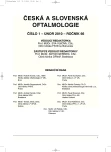The Influence of the Lens Capsule Mechanical Polishing to the Secondary Cataract Development
Authors:
R. Švancarová; J. Novák; H. Adámková
Authors‘ workplace:
Oční oddělení Pardubické krajské nemocnice, a. s., přednosta doc. MUDr. Jan Novák, CSc.
Published in:
Čes. a slov. Oftal., 66, 2010, No. 1, p. 21-25
Overview
Aim:
The aim of the prospective study was to evaluate the long-term effect of the lens epithelial cells (LEC) removal by means of the lens capsule mechanical polishing on the development of the anterior capsule opacification (ACO) and posterior capsule opacification (PCO).
Materials and methods:
The study group consisted of 28 patients, average age 57 years (27 – 87 years), who underwent the cataract surgery of both eyes. Out of the 28 patients, the follow up examination after two or more years attended 23 of them. For the irrigation and aspiration after the phacoemulsification, the bimanual (newly also called biaxial) irrigation/aspiration from two service, 1 mm wide, opposite (at the 3 and 9 o’clock positions) incisions was used. In each patient, the lens capsule of one eye was mechanically polished in the maximal mydriasis (at least 5 minutes) with a specially constructed 5 openings aspiration cannula designated especially for the LEC aspiration in the equator area. The anterior capsule was cleaned by means of the standard one opening aspiration cannula. In the other eye of the same patient, the LEC of the anterior capsule were left intact. There was implanted the same type of the intraocular lens in both eyes. The examination after more than two years after the surgery consisted of biomicroscopic examination, taking the photograph of the intraocular lens and the lens capsule in retro illumination, and examining of the anterior segment by means of the Scheimpflug camera (Pentacam) with measuring the density of the anterior and posterior lens capsule. The Wilcoxon pair test was used for the statistical evaluation.
Results:
Using the Pentacam system objective densitometry, there was found statistically significant lower density of the anterior lens capsule in eyes with peroperative mechanical polishing of the lens capsule including the equator and the anterior capsule. Among the values of the density of the posterior capsule, there were found no statistically significant differences, although in 43 % of patients, in the eye with the polished capsule, there were visually less dense opacities of the posterior capsule.
Conclusions:
According to the obtained results it may be stated that the mechanical polishing of the lens capsule, including the equator and the anterior capsule, causes significantly lower degree of opacities of the anterior capsule (ACO), but has not statistically significant influence to the development of the PCO.
Key words:
Secondary cataract, anterior capsule opacification (ACO), posterior capsule opacification (PCO), lens epithelial cells (LEC), 5 openings cannula.
Sources
1. Baráková D., Kuchynka P., Klečka D. et al.: Frekvence výskytu sekundární katarakty u AcrySof MA30BA a MA60BM. Cesk Slov Oftalmol, 2000; 56: 38–42.
2. Benda F., Mašek P.: Primární polypseudofakie u pacientů s kataraktou a hypermetropií. Čes a Slov Oftalmol, 2001; 57: 226–30.
3. Bertelmann E., Kojetinsky C.: Posterior capsule opacification and anterior capsule opacification. Current Opinion in Ophthalmology, 2001; 12: 35–40
4. Krajčová P., Chynoranský M., Strmeň P.: Opacifikácia zadného puzdra šošovky po implantácii rôznych typov umelých vnútroočných šošoviek – II. časť: rôzne peroperačné nálezy. Čes a Slov Oftalmol, 2008; 64: 13–15
5. Kruger A., Amon M., Schauersberger J. et al.: Anterior capsule opacification and lens epithelial outgrowth on the intraocular lens surface after curettage. J Cataract Refract Surg, 2001; 27: 1987–1991
6. Mahelková G., Bacáková L., Korynta J. et al.: Effect of culture substrate and culture conditions on lens epithelial cell proliferation and alpha-smooth muscle actin expression. Folia Biol (Praha), 2009; 55: 66–76
7. Menapace R., Wirtitsch M., Findl O. et al.: Effect of anterior capsule polishing on posterior capsule opacification and neodymium:YAG capsulotomy rates: Three-year randomized trial. J Cataract Refract Surg, 2005; 31: 2067–2075
8. Nekolová J., Pozlerová J., Jirásková N. et al.: Pooperační výsledky expandibilní nitrooční čočky ACQUA (Mediphacos). Čes a Slov Oftalmol., 2008; 64: 87–90
9. Novák J.: Comparison of one opening and five openings aspirating handpiece for the lens epithelial cells (LEC) removal. Abstract book of XX. ESCRS Congress, Nice 2002: 181
10. Peng Q., Visessook N., Apple D.: Surgical prevention of posterior capsule opacification, Part 3: Intraocular lens optic barrier effect as a second line of defense. J Cataract Refract Surg, 2000; 26: 198–213
11. Sacu S., Menapace R., Findl O. et al.: Influence of optic edge design and anterior capsule polishing on posterior capsule fibrosis. J Cataract Refract Surg, 2004; 30: 658–662
12. Sacu S., Menapace R., Wirtitsch M. et al.: Effect of anterior capsule polishing on fibrotic capsule opacification: Three-year results. J Cataract Refract Surg, 2004; 30: 2322–2327
Labels
OphthalmologyArticle was published in
Czech and Slovak Ophthalmology

2010 Issue 1
Most read in this issue
- Our Two – Years Experience with the Bevacizumab (Avastin) Treatment of the Age Related Macular Degeneration Wet Form
- The Influence of the Lens Capsule Mechanical Polishing to the Secondary Cataract Development
- Bacillus Cereus Keratitis – Case Report
- The Impact of Implantation of Intraocular Lenses with Negative Spherical Aberration on Contrast Sensitivity
